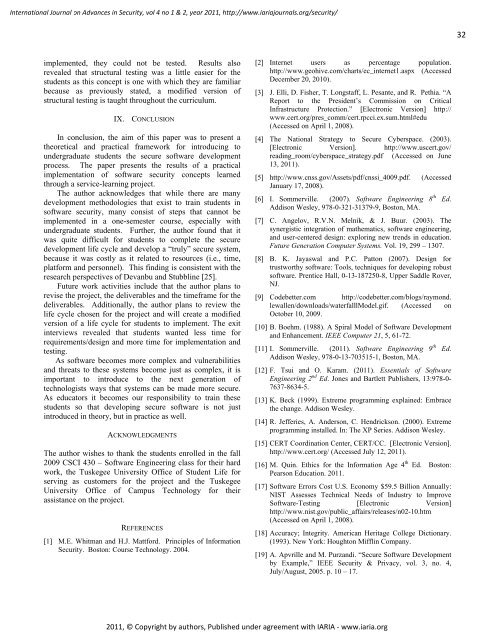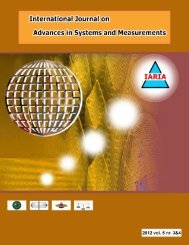Fault Tolerance Framework using Model-Based - IARIA Journals
Fault Tolerance Framework using Model-Based - IARIA Journals
Fault Tolerance Framework using Model-Based - IARIA Journals
You also want an ePaper? Increase the reach of your titles
YUMPU automatically turns print PDFs into web optimized ePapers that Google loves.
International Journal on Advances in Security, vol 4 no 1 & 2, year 2011, http://www.iariajournals.org/security/<br />
implemented, they could not be tested. Results also<br />
revealed that structural testing was a little easier for the<br />
students as this concept is one with which they are familiar<br />
because as previously stated, a modified version of<br />
structural testing is taught throughout the curriculum.<br />
IX. CONCLUSION<br />
In conclusion, the aim of this paper was to present a<br />
theoretical and practical framework for introducing to<br />
undergraduate students the secure software development<br />
process. The paper presents the results of a practical<br />
implementation of software security concepts learned<br />
through a service-learning project.<br />
The author acknowledges that while there are many<br />
development methodologies that exist to train students in<br />
software security, many consist of steps that cannot be<br />
implemented in a one-semester course, especially with<br />
undergraduate students. Further, the author found that it<br />
was quite difficult for students to complete the secure<br />
development life cycle and develop a “truly” secure system,<br />
because it was costly as it related to resources (i.e., time,<br />
platform and personnel). This finding is consistent with the<br />
research perspectives of Devanbu and Stubbline [25].<br />
Future work activities include that the author plans to<br />
revise the project, the deliverables and the timeframe for the<br />
deliverables. Additionally, the author plans to review the<br />
life cycle chosen for the project and will create a modified<br />
version of a life cycle for students to implement. The exit<br />
interviews revealed that students wanted less time for<br />
requirements/design and more time for implementation and<br />
testing.<br />
As software becomes more complex and vulnerabilities<br />
and threats to these systems become just as complex, it is<br />
important to introduce to the next generation of<br />
technologists ways that systems can be made more secure.<br />
As educators it becomes our responsibility to train these<br />
students so that developing secure software is not just<br />
introduced in theory, but in practice as well.<br />
ACKNOWLEDGMENTS<br />
The author wishes to thank the students enrolled in the fall<br />
2009 CSCI 430 – Software Engineering class for their hard<br />
work, the Tuskegee University Office of Student Life for<br />
serving as customers for the project and the Tuskegee<br />
University Office of Campus Technology for their<br />
assistance on the project.<br />
REFERENCES<br />
[1] M.E. Whitman and H.J. Mattford. Principles of Information<br />
Security. Boston: Course Technology. 2004.<br />
[2] Internet users as percentage population.<br />
http://www.geohive.com/charts/ec_internet1.aspx (Accessed<br />
December 20, 2010).<br />
[3] J. Elli, D. Fisher, T. Longstaff, L. Pesante, and R. Pethia. “A<br />
Report to the President’s Commission on Critical<br />
Infrastructure Protection.” [Electronic Version] http://<br />
www.cert.org/pres_comm/cert.rpcci.ex.sum.html#edu<br />
(Accessed on April 1, 2008).<br />
[4] The National Strategy to Secure Cyberspace. (2003).<br />
[Electronic Version]. http://www.uscert.gov/<br />
reading_room/cyberspace_strategy.pdf (Accessed on June<br />
13, 2011).<br />
[5] http://www.cnss.gov/Assets/pdf/cnssi_4009.pdf. (Accessed<br />
January 17, 2008).<br />
[6] I. Sommerville. (2007). Software Engineering 8 th Ed.<br />
Addison Wesley, 978-0-321-31379-9, Boston, MA.<br />
[7] C. Angelov, R.V.N. Melnik, & J. Buur. (2003). The<br />
synergistic integration of mathematics, software engineering,<br />
and user-centered design: exploring new trends in education.<br />
Future Generation Computer Systems. Vol. 19, 299 – 1307.<br />
[8] B. K. Jayaswal and P.C. Patton (2007). Design for<br />
trustworthy software: Tools, techniques for developing robust<br />
software. Prentice Hall, 0-13-187250-8, Upper Saddle Rover,<br />
NJ.<br />
[9] Codebetter.com http://codebetter.com/blogs/raymond.<br />
lewallen/downloads/waterfalll<strong>Model</strong>.gif. (Accessed on<br />
October 10, 2009.<br />
[10] B. Boehm. (1988). A Spiral <strong>Model</strong> of Software Development<br />
and Enhancement. IEEE Computer 21, 5, 61-72.<br />
[11] I. Sommerville. (2011). Software Engineering 9 th Ed.<br />
Addison Wesley, 978-0-13-703515-1, Boston, MA.<br />
[12] F. Tsui and O. Karam. (2011). Essentials of Software<br />
Engineering 2 nd Ed. Jones and Bartlett Publishers, 13:978-0-<br />
7637-8634-5.<br />
[13] K. Beck (1999). Extreme programming explained: Embrace<br />
the change. Addison Wesley.<br />
[14] R. Jefferies, A. Anderson, C. Hendrickson. (2000). Extreme<br />
programming installed. In: The XP Series. Addison Wesley.<br />
[15] CERT Coordination Center, CERT/CC. [Electronic Version].<br />
http://www.cert.org/ (Accessed July 12, 2011).<br />
[16] M. Quin. Ethics for the Information Age 4 th Ed. Boston:<br />
Pearson Education. 2011.<br />
[17] Software Errors Cost U.S. Economy $59.5 Billion Annually:<br />
NIST Assesses Technical Needs of Industry to Improve<br />
Software-Testing [Electronic Version]<br />
http://www.nist.gov/public_affairs/releases/n02-10.htm<br />
(Accessed on April 1, 2008).<br />
[18] Accuracy; Integrity. American Heritage College Dictionary.<br />
(1993). New York: Houghton Mifflin Company.<br />
[19] A. Apvrille and M. Purzandi. “Secure Software Development<br />
by Example,” IEEE Security & Privacy, vol. 3, no. 4,<br />
July/August, 2005. p. 10 – 17.<br />
2011, © Copyright by authors, Published under agreement with <strong>IARIA</strong> - www.iaria.org<br />
32







